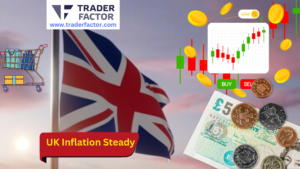Today, the Euro to Dollar (EURUSD) exchange rate has been hovering around the 1.0600 mark, following the release of mixed US personal consumption expenditures (PCE) data.

The EURUSD saw a slight increase of 0.20%, or +0.0021, to stand at 1.0580. The fluctuation comes in the wake of the US Bureau of Economic Analysis report indicating a decrease in PCE by $20.8 billion (0.1 percent) in August 2023. Meanwhile, personal income saw an increase of $70.7 billion (0.3 percent).
The mixed data indicates a cautious spending behavior among US consumers, which may reflect uncertainty about the economic outlook. Despite a rise in personal income, the dip in personal consumption suggests that consumers are choosing to save rather than spend, pushing the personal saving rate to 12.9 percent.
The EURUSD pair is one of the most traded currency pairs in the world, and its performance is influenced by many factors, including economic indicators from both the Eurozone and the United States. Today’s slight increase in the EURUSD rate could be a reaction to the mixed US economic data, as Forex traders try to digest what this could mean for future monetary policy decisions from the Federal Reserve.
U.S. Personal Income and Outlays Show Mixed Trends in August 2023
In a recent report by the Bureau of Economic Analysis (BEA), the trends in personal income and outlays for August 2023 were revealed, showcasing a mixed picture of the U.S. economy.
The BEA reported that personal income increased $70.7 billion (0.3 percent) in August. Disposable personal income (DPI) also rose by $39.9 billion (0.2 percent). However, personal consumption expenditures (PCE) decreased by $20.8 billion (0.1 percent).
In real terms, after accounting for inflation, DPI increased by 0.1 percent and PCE decreased by 0.3 percent. The PCE price index increased by 0.2 percent. Excluding food and energy, the PCE price index increased by 0.1 percent.
The increase in personal income in August primarily reflected increases in wages and salaries, private social benefits, and rental income of persons. Partially offsetting these increases were decreases in proprietors’ income and personal interest income.
The $11.6 billion decrease in real PCE in August reflected a decrease of $8.7 billion in spending for goods and a $2.9 billion decrease in spending for services. Within goods, spending for “other” nondurable goods was the leading contributor to the decrease. Within services, the largest contributor to the decrease was spending for health care.
Personal outlays decreased by $23.6 billion in August. Personal saving was $1,554.9 billion in August, and the personal saving rate—personal saving as a percentage of disposable personal income—was 12.9 percent.
As we navigate through the economic impacts of recent events, these figures provide valuable insights into the financial behaviour of U.S. households, and are crucial for policymakers and economists alike.
USDCAD Dips Below 1.3500 Following Release of Canadian GDP Data
The United States Dollar to Canadian Dollar (USDCAD) exchange rate dipped below the 1.3500 mark today, trading at 1.3468, a decrease of 0.13% or -0.0018, in light of the recently released Canadian Gross Domestic Product (GDP) data.

The GDP growth for July 2023 was reported at 0.6%, exceeding economists’ expectations of 0.4%. The robust economic performance, primarily driven by the manufacturing sector, has provided a boost to the Canadian Dollar (CAD), causing the USDCAD pair to trade lower.
The manufacturing sector saw an increase of 1.2%, marking its third consecutive month of growth. Other significant contributions came from the construction and retail trade sectors, which grew by 2.8% and 2.1% respectively.
On the downside, the oil and gas extraction industry contracted by 1.1%, largely due to maintenance shutdowns in Newfoundland and Labrador.
The USDCAD is one of the key currency pairs watched by forex traders worldwide. It is significantly influenced by economic indicators from both countries and changes in global commodity prices, particularly oil, given Canada’s role as a major exporter.
As the market digests the positive Canadian GDP data, Forex traders will also keep an eye on upcoming U.S. PCE data for further direction.
Looking ahead, the trajectory of the USDCAD pair could be influenced by other factors, including any changes in monetary policy by the Federal Reserve and the Bank of Canada, as well as geopolitical developments.
Canada’s Economy Grows by 0.6% in July, Exceeds Expectations
Canada’s economy showed signs of resilience as it expanded more than expected in July 2023, according to data released by Statistics Canada. The nation’s gross domestic product (GDP) grew by 0.6% in July, beating economists’ expectations of a 0.4% increase.
The growth was largely driven by the manufacturing sector, which saw a robust increase of 1.2%, marking its third consecutive month of growth. Other notable contributions came from the construction industry, which grew by 2.8%.
The retail trade sector also witnessed a 2.1% expansion, recovering from a decline in the previous month. The wholesale trade sector, on the other hand, remained steady with a slight increase of 0.2%.
In contrast, the oil and gas extraction industry faced a contraction of 1.1%, largely due to maintenance shutdowns in Newfoundland and Labrador.
Despite the challenges posed by the ongoing global pandemic, Canada’s economy has shown a strong recovery, bouncing back from the 0.5% contraction seen in April. The July figures are the latest in a series of positive economic data, suggesting that the country is on track for a solid third quarter.
However, economists warn that the path of recovery could still be bumpy, given the uncertainty surrounding the COVID-19 situation and other global economic factors.
“Canada’s economy is showing signs of resilience, but we’re not out of the woods yet,” said one economist. “We need to continue monitoring the situation closely and adapt our strategies accordingly.”
As Canada moves forward, policy-makers will need to balance the need for economic growth with the ongoing health crisis, ensuring that the recovery is sustainable and inclusive.
Source: Statistics Canada
Read These Next
Creating an Effective Forex Trading Plan
The Winning Mindset for Weekend Forex Trading
Essential Education for Taxes on Forex Trading
What is a Margin Level in Forex?
Forex Breakout Strategy: A Guide for Profitable Trading
Forex Consolidation Breakout Strategies for Traders
Master Forex Flag Pattern Strategy for Profit
Disclaimer:
All information has been prepared by TraderFactor or partners. The information does not contain a record of TraderFactor or partner’s prices or an offer of or solicitation for a transaction in any financial instrument. No representation or warranty is given as to the accuracy or completeness of this information. Any material provided does not have regard to the specific investment objective and financial situation of any person who may read it. Past performance is not a reliable indicator of future performance.
Author
-

Phyllis Wangui is a Financial Analyst and News Editor with qualifications in accounting and economics. She has over 20 years of banking and accounting experience, during which she has gained extensive knowledge of the forex, stock news, stock market, forex analysis, cryptos and foreign exchange industries. Phyllis is an avid commentator on these topics and loves to share her insights with others through financial publications and social media platforms.
View all posts



















